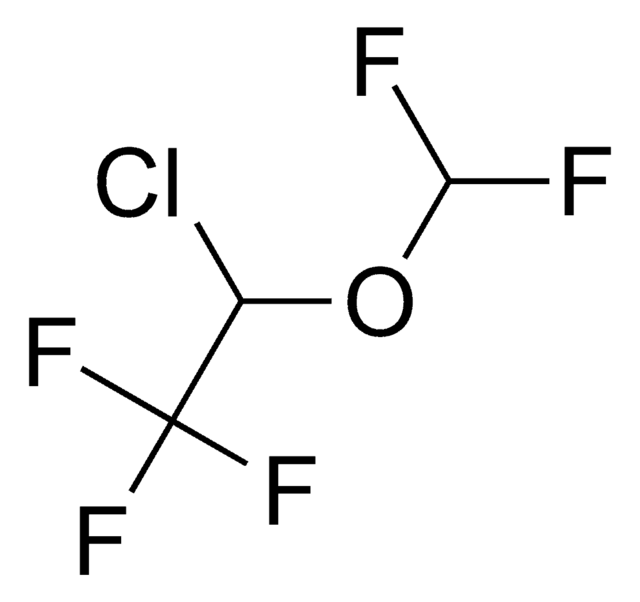Key Documents
B4388
2-Bromo-2-chloro-1,1,1-trifluoroethane
≥99%
Synonim(y):
Halothane
About This Item
Polecane produkty
ciśnienie pary
4.5 psi ( 20 °C)
Poziom jakości
Próba
≥99%
Postać
liquid
zawiera
0.01% thymol as stabilizer
współczynnik refrakcji
n20/D 1.369 (lit.)
tw
50.2 °C (lit.)
gęstość
1.872 g/mL at 25 °C (lit.)
ciąg SMILES
FC(F)(F)C(Cl)Br
InChI
1S/C2HBrClF3/c3-1(4)2(5,6)7/h1H
Klucz InChI
BCQZXOMGPXTTIC-UHFFFAOYSA-N
informacje o genach
human ... ATP5D(513) , GABRA1(2554) , GABRA2(2555) , GABRA3(2556) , GABRA4(2557) , GABRA5(2558) , GABRA6(2559) , GABRB1(2560) , GABRB2(2561) , GABRB3(2562) , GABRD(2563) , GABRE(2564) , GABRG1(2565) , GABRG2(2566) , GABRG3(2567) , GABRP(2568) , GABRQ(55879) , GLRA1(2741) , GLRB(2743) , GRIA1(2890) , KCNK10(54207) , KCNK18(338567) , KCNK2(3776) , KCNK3(3777) , KCNK9(51305) , KCNN4(3783)
Szukasz podobnych produktów? Odwiedź Przewodnik dotyczący porównywania produktów
Zastosowanie
Działania biochem./fizjol.
Hasło ostrzegawcze
Danger
Zwroty wskazujące rodzaj zagrożenia
Zwroty wskazujące środki ostrożności
Klasyfikacja zagrożeń
Eye Dam. 1 - Repr. 1B - Skin Irrit. 2 - STOT SE 3
Organy docelowe
Respiratory system
Kod klasy składowania
6.1C - Combustible acute toxic Cat.3 / toxic compounds or compounds which causing chronic effects
Klasa zagrożenia wodnego (WGK)
WGK 3
Temperatura zapłonu (°F)
Not applicable
Temperatura zapłonu (°C)
Not applicable
Środki ochrony indywidualnej
Eyeshields, Gloves
Certyfikaty analizy (CoA)
Poszukaj Certyfikaty analizy (CoA), wpisując numer partii/serii produktów. Numery serii i partii można znaleźć na etykiecie produktu po słowach „seria” lub „partia”.
Masz już ten produkt?
Dokumenty związane z niedawno zakupionymi produktami zostały zamieszczone w Bibliotece dokumentów.
Klienci oglądali również te produkty
Nasz zespół naukowców ma doświadczenie we wszystkich obszarach badań, w tym w naukach przyrodniczych, materiałoznawstwie, syntezie chemicznej, chromatografii, analityce i wielu innych dziedzinach.
Skontaktuj się z zespołem ds. pomocy technicznej











